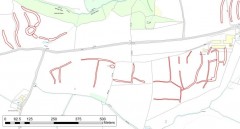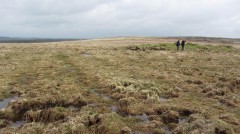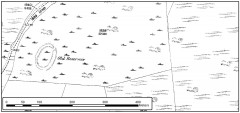Farming has played a major part in shaping the landscape of the AONB. The field pattern as depicted on the late nineteenth century Ordnance Survey mapping has a predominantly medieval historic character, with areas dominated by post-medieval enclosure and rough ground.
Former field boundaries visible on aerial photographs as relict earthwork banks or cropmarks frequently have the curving character typical of enclosures based on medieval strip fields. This distinctive pattern resulted from many years of cultivation, the soil being ploughed inwards to the centre of the individual long and thin land parcels, and the curve developing from the repeated turning of the plough team at the end of the strips.
Some of the steep slopes that characterise many parts of the AONB are swathed with relict medieval boundary banks, striping the hillside with parallel curving earthworks.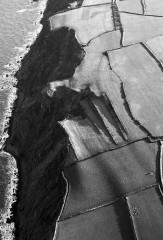
Cultivation terraces at Gawlish. DCC DAP/HL 7 22-DEC-1986. Photo © Frances Griffith, Devon County Council.
Although a relatively high proportion of medieval field boundaries have become disused or deliberately removed to create larger fields in more recent years, very close to the AONB is the nationally important open field system of Braunton Great Field (MDV199). This is a rare survival of a medieval pattern of farming where different farmers cultivate adjacent strips of land separated only by low earthwork baulks. Assessment of the aerial photographs illustrated just how many baulks appear to have been removed since the Second World War, impacting on the character and feel of this extremely unusual open farmed landscape.
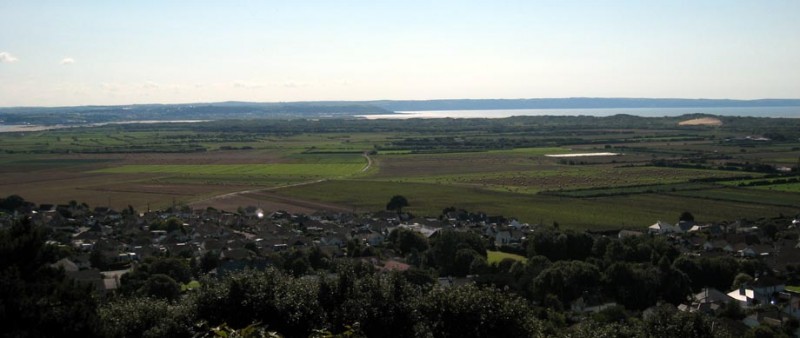
Some of the relict boundaries identified from aerial photographs however do not fit into a typical medieval or post-medieval field pattern. A particular complex of cropmark and low earthwork field boundaries (MDV103201) more closely resembles a prehistoric field system. It is interesting that these are close to the hilltop enclosure of probable Iron Age date at North Hill Cleave.
A possible later prehistoric field system near Ilfracombe. NMP mapping © English Heritage. The base map is © Crown Copyright and database right 2013. Ordnance Survey 100019783.
An intriguing feature in East Down parish recorded from aerial photographs taken in 1976 could be another example of prehistoric land division. At least 16 roughly circular cropmarks are visible in a line approximately 130 metres long (MDV103248), intersecting with some rectilinear enclosures of late prehistoric type. It strongly resembles a pit alignment; examples elsewhere have been dated to the Iron Age or earlier, and interpreted as a conceptual, if not physical, boundaries (Cunliffe 2005).
It is interesting that these cropmarks were only observed on aerial photographs taken in the summer of a drought year. When under stress, crops growing over infilled pits have greater access to moisture from the more humic soil in the pit fill, so they grow and ripen at a different rate to those growing over a standard depth of ploughsoil, forming a cropmark visible from the air.
Livestock have traditionally played a considerable part in the rural economy of Devon, but you might be surprised by one high status medieval meat source: the rabbit. Warrens were maintained by large estates to protect rabbit colonies from predators, a strange concept perhaps now that rabbits are more often seen as pets or pests, but their meat was once prized. Several possible ‘pillow mounds’ (artificial warrens) were recorded during the aerial survey near Hartland (MDV81252; MDV81219) and a nearby cropmark could point to the location of another warren (MDV102087).
In the nineteenth century agricultural improvement fundamentally changed how the landscape looked and functioned. Narrow parallel earthwork furrows are visible on aerial photographs and cumulatively cover a large proportion of the western part of the AONB. Deep ploughing to improve drainage of these wetter soils is particularly prominent on areas that were depicted as rough ground, and therefore less agriculturally productive, on the late nineteenth century Ordnance Survey maps (MDV81283; MDV81304; MDV81342). Peat cutting pits appear to have been cut between some of the ridges and it seems that peat extraction occurred after the attempt at drainage (MDV102325). The furrows are sometimes still visible, especially on land that has remained as rough ground (MDV102323).
Earthwork furrows from agricultural improvement operations on Bursdon Moor, with one of the Bronze Age barrows (right). Photograph: Cain Hegarty.
Works to increase agricultural productivity have also left their mark on the east of the National Landscape, where valley watermeadows, locally known as catchmeadows, are visible as linear ditches or ‘field gutters’ dug out along the contour. They distributed water over the valley sides to keep the ground warmer and speed up the growth of grass for pasture in the spring. Some are complex systems linked to farmsteads to incorporate manure into the gutters (MDV102261) whilst others are more simple comprising a few spring or stream fed gutters (MDV103104; MDV103105). There were relatively few in the National Landscape compared to Exmoor, probably a result of differing geology and topography.
Some larger and unusual features for managing water flow were recorded in what is now Summerwell Moor Plantation (MDV102329). They are horseshoe-shaped in plan, and one was marked ‘Old Reservoir’ on late nineteenth century Ordnance Survey maps, but the earthworks have similarities to what appear to be natural curving banks in the wider area. Could they have been enhanced or re-used natural formations? If you know more about these features we’d like you to contact us!
’Old Reservoir’ on Summerwell Moor in the late nineteenth century. First Edition Ordnance Survey 25 inch map, 1886-1888 © Crown copyright and Landmark Information Group Ltd.
Reservoir earthworks in Summerwell Moor 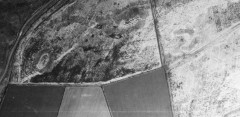
Rural settlements in North Devon tend to be long-lived, but some evidence of long-abandoned settlements was seen on the aerial photographs. This included previously unrecorded probable farmsteads of later prehistoric or Romano-British type in the west of the project area, with an outer enclosure ditch visible as a roughly rectangular cropmark (MDV102463; MDV102421; MDV102358). Further east several additional ovoid enclosures with an earthwork bank were recorded (MDV102287; MDV102576) complementing the previously recorded examples (MDV16955; MDV16053), and these are likely to have a similar date of origin.
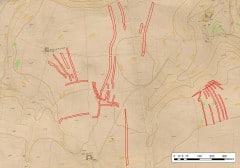
Deserted or shrunken settlements of medieval origin were also inferred from aerial photographic evidence at Dadworthy (MDV81183), Mullacott (MDV103139) and possibly Seckington (MDV102288).
Cunliffe, B. 2005 Iron Age Communities in Britain: An Account of England, Scotland and Wales from the Seventh Century BC until the Roman Conquest. Routledge.
